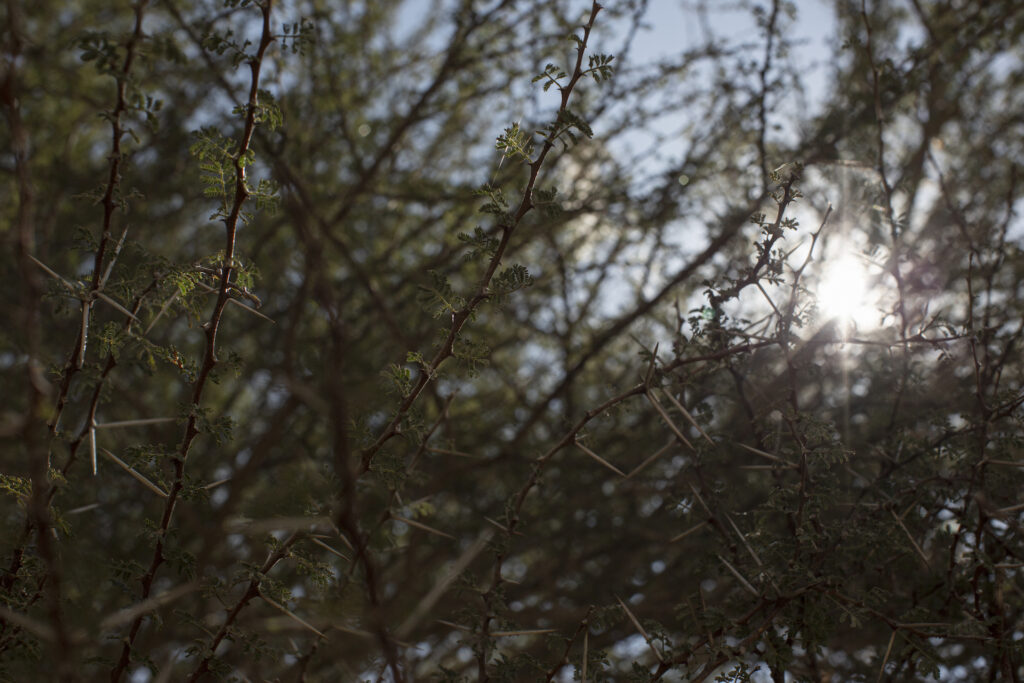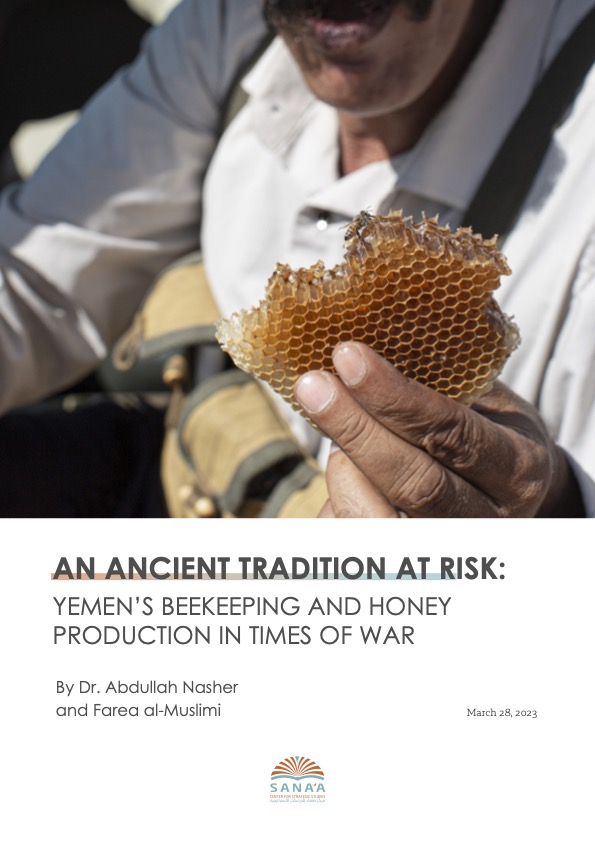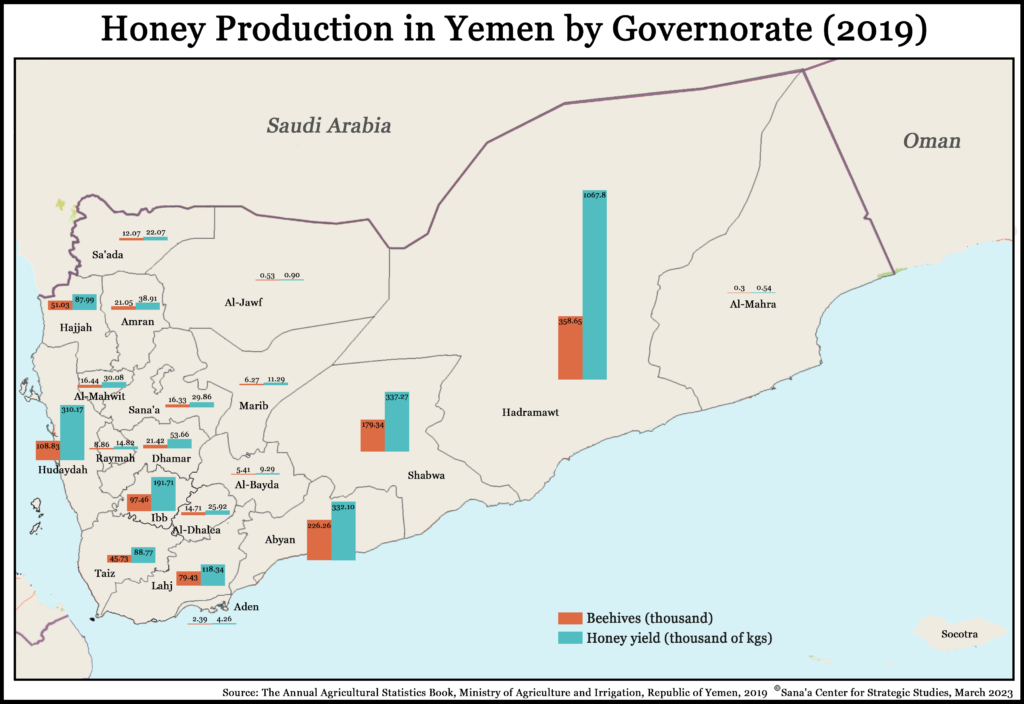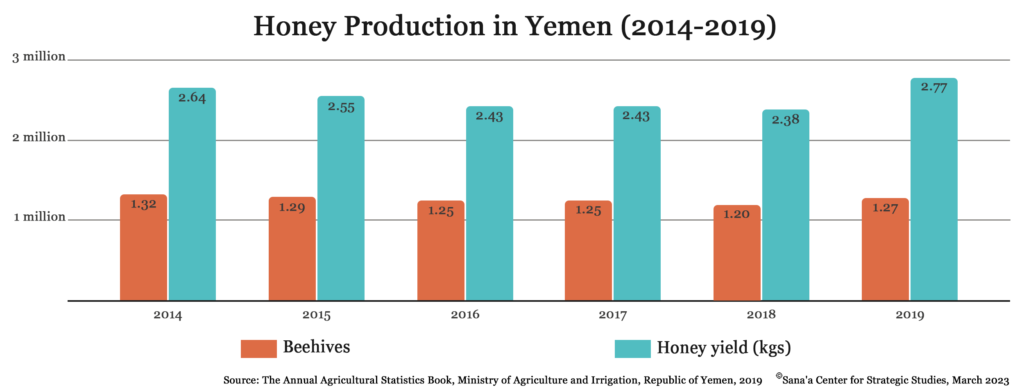Beekeeping in Yemen is as ancient as Yemeni civilization itself. Yemenis have mastered their beekeeping skills over centuries and can trace their rich heritage in apiculture (beekeeping) back to their pre-Islamic ancestors. In the Kingdom of Hadramawt, during the 10th century BC, trading honey was reported to have been the fourth largest economic sector.[1] Greek historian and philosopher Strabo (64 BC – 24 AD) wrote about honey being a popular commodity in Yemen, observing how Yemenis climbed mountains in search of bee colonies, including Yemen’s Beni Saleem Mountains, which were known for their abundance of honey and have maintained this reputation since pre-Islamic times.[2] To this famed liquid gold, Yemeni lyricists, poets, and singers have in more recent times offered their praise. Ya Asal Do’an (Oh Honey from Do’an),[3] written by poet Hussein Mehdar and sung by the legendary singer Abu Bakr Salem, is just one example of how honey is deeply embedded in Yemen’s popular culture now as it was a thousand years ago.
Today, Yemeni honey is one of the world’s most popular and expensive honey on the market.[4] Widespread in most governorates of Yemen, Hadramawt ranks first in terms of honey production, followed by Shabwa, Abyan, and Hudaydah.[5] The uniqueness of Yemeni honey is due to the distinctive wilderness of Yemen’s bee pastures, found in landscapes ranging from coastlines to mountains, highlands, plains, valleys, and deserts rich in diverse plant life.[6] Of these, the finest honey comes from bees fed exclusively on the flowers of Sidr trees,[7] also known as Christ’s thorn jujube (Ziziphus spina Christi), which abundantly grow in Yemen. Renowned for being pure, unprocessed, and free from chemicals, the net price of a kilo of honey derived from Sidr trees costs at least US$75 in Yemen. Abroad, a kilo of Sidr honey can fetch US$500.
Until recently, honey production had been a lucrative trade for Yemenis. In 2003, honey was one of the five commodities declared by the Yemeni government as a strategic product that can boost the country’s economy. In 2002, the Ministry of Agriculture estimated the number of Yemeni beekeepers to be 81,734.[8] Today, beekeeping continues to represent an important source of income for many low-income (mostly rural) households. A 2020 UN report estimated that around 100,000 households were working in the honey industry and noted a growing trend of Yemeni youth joining the trade.[9] The demographics of beekeepers appear to indeed be changing since the war,[10] from a niche dominated by veteran beekeepers, many of whom inherited the trade from their families, to a sector witnessing an increase in newcomers. These include government employees, who haven’t received regular salaries since the start of the conflict, and who have sought new income-generating activities, as well as internally displaced people who have resorted to beekeeping after moving from cities to more rural areas where bee pastures are located.[11] While in theory such shifts seem promising, among traditional beekeepers the rapid changes that have been triggered by the war seem to be steadily threatening an ancient way of life.
The beekeeping trade in Yemen today faces growing challenges, foremost among which are the curb of its export to the international market; the difficulties in moving bee colonies between pastures due to landmines and checkpoints; the high price of fuel, which has led to the logging of Sidr trees; the effect of climate change; pesticide spraying that harms bees; and arbitrary levies on beekeepers in areas that fall under the control of the de facto authorities in Sana’a as part of their zakat (alms) policies. Based on oral and written sources, as well as discussions held by the authors with Yemeni beekeepers, this analysis explores some of the main challenges confronting Yemen’s honey trade since the war.
A Trade in Jeopardy

Notorious for its medicinal properties and organic, Yemeni honey has historically been held in high regard and in high demand. In recent decades, the biggest market for the export of Yemeni honey has been the Gulf. In their heyday, well-known beekeepers from Shabwa and Hadramawt were known to cater to the likes of Gulf royals and sheikhs, who would book their honey orders years in advance, mediated by traders of Yemeni origin residing in Saudi Arabia and the wider Gulf region. Although there is still demand, restrictions on shipping and the movement of goods and people since the outbreak of war have made exports from Yemen difficult and dented an otherwise lucrative business for both beekeepers and honey traders. At the start of the conflict, DHL, FedEx, and other shipping companies ceased their operations in Yemen, depriving honey producers of an avenue to access foreign markets. Later, in 2016, an outbreak of cholera in Yemen, and inflated figures cited by international aid organizations to attract more funding, prompted many countries, including Jordan and Egypt, to impose a ban on agricultural products from Yemen, which included honey and fish. Compounding matters is the fact that the credibility of Yemeni honey has been tainted in recent years by some traders who have gotten into the habit of mixing inferior types of honey with Yemeni honey to increase profit.[12] Restoring Yemeni honey’s reputation[13] would need a stronger regulatory framework and specialized laboratories in Yemen that can assure buyers of its quality before export, measures that are currently missing in Yemen.[14] Looking ahead, once exports resume, Yemen would also need to better safeguard its honey in the international market, doing justice to the fact it represents one of the country’s most prized exportable goods.[15]
Landmines and Checkpoints Hinder Beekeepers’ Movements
Beekeeping in Yemen remains largely a traditional[16] and nomadic sector relying on movement between different pastures throughout the year. Unlike most honey producers worldwide, who predominantly rely on static apiaries, Yemeni beekeepers move their bee colonies between the mountains, valleys, and plains in pursuit of suitable pasture. Like shepherds, beekeepers are particularly vulnerable to injury or death from landmines that have been widely planted since the war.[17] The increase in the number of security checkpoints as a by-product of the conflict has also disrupted previously seamless journeys from one pasture to another. Beekeepers need to move their bees at night, when the bees are less active, making it doubly hard to pass through security checkpoints weary of movement after dark. Restrictions on beekeepers’ movements, who are often stopped or delayed at checkpoints, mean that bountiful pasture areas for bees remain unutilized, leading to significant losses in honey production, but also, in some cases, to the death of entire bee colonies. Areas that remain unutilized due to restricted access, ongoing battles, or landmines can lead to an overcrowding of bee colonies in areas easier to access. A female beekeeper from Wessab in Dhamar governorate observed that “a bee does not feed from a flower that another bee has already fed from,” underscoring a challenge that emerges when too many beekeepers work in close proximity.[18] Other beekeepers concurred and said that when overcrowded, bees end up going back to their hives hungry and sometimes eat the honey they already produced.[19]
Arbitrary Zakat Imposed on Beekeepers

Beekeepers who fall under the control of the de facto authorities in Sana’a face additional pressure with alms (zakat) imposed on them. Yemen’s 1999 zakat law[20] clearly stipulates how much zakat is due on honey. In the past, tax would be levied according to how many kilos of honey beekeepers produce a year, but recently, beekeepers are being taxed on the number of hives they own.[21] This is problematic given that in some years hives can produce very little to no honey. Also, not all honey produced is sold; among poorer beekeepers, honey is often used for personal consumption or traded in-kind for other basic goods. As they move their bees from one area to another, beekeepers are reportedly being detained at checkpoints on the pretext of not paying zakat. Caught between a rock and hard place, they either succumb and pay zakat based on the arbitrary estimates of those manning checkpoints (in violation of the law) or refuse to pay, in which case their bees face a slow death. Often beekeepers find themselves paying to avert any harm to their bee colonies. Making matters worse, beekeepers are in some cases reportedly forced to doubly pay zakat each time they relocate their bee colonies within areas controlled by the de facto authorities in Sana’a, imposing additional financial burdens and making life difficult for those already struggling with the multifaceted impact of war on their trade.[22]
Climate Change and War Threaten Yemen’s Famed Sidr Trees
Sidr trees abound across Yemen’s valleys, plains, and mountains, from coastal areas up to the highlands 2500 meters above sea level. They are resilient and can survive in areas with low rainfall (50-300 millimeters annually) as well as in the arid desert due to their ability to withstand high temperatures and drought.[23] Yemen’s famed Sidr honey[24] comes in a number of varieties, with the most sought-after ones being the Sidr al-Doani (produced in Wadi Do’an in Hadramawt), Sidr al-Osaymi (produced in the Osaymat area of Amran governorate), Sidr al-Jardani (produced in Jardan district in Shabwa ), and Sidr al-Wessabi (produced in the Wessab region of Dhamar governorate).[25] Large populations of perennial Sidr trees, whose lifespan can extend hundreds of years, flourish in these areas. The fact that there are no bee pastures that blossom simultaneously with Sidr trees means the quality of the Sidr honey produced from these areas, where bees feed exclusively on Sidr flowers, is particularly high.

Unseasonal rains in Yemen triggered by changing climate patterns are, however, throwing off flowering seasons and making it hard for beekeepers to gauge when best to feed their bees.[26]Heavy downpours in recent years have knocked flowers off the branches of Sidr trees before bees could get to them.[27] Rising poverty in Yemen has also led to an increase in illegal logging, including that of Sidr trees. Demand for firewood for cooking and heating purposes has soared due to fuel shortages and the high cost and regular shortage crisis of cooking gas which has led people to resort to the chopping of trees for both subsistence and to earn a living. Displacement due to armed clashes, particularly in coastal areas, has also led to more logging by displaced Yemenis who chop trees to build makeshift houses or to produce charcoal.[28] The extent of damage from the logging of trees on Yemen’s floral environment and honey production is yet to be examined, but illegal logging appears to be widely prevalent, including in nature reserves such as Ottomah.[29] What is certain is that the effects of climate change, and the slim likelihood of future governments investing in the replacement of ruined pastures at the rate and investment needed, will have a lasting impact, with clear implications on people’s livelihoods, but also on Yemen’s ancient craft.
Pesticides Harming Yemen’s Honey Bees
Small, strong, and highly resistant to diseases, Yemen’s honey bees (Apis mellifera jemenetica[30]) are typically known for being a healthy bee subspecies. Part of the reason why Yemeni honey is so highly sought after is that Yemeni beekeepers generally do not need to use chemicals that are commonly utilized internationally to control diseases affecting bees,[31] which normally leave antibiotic residue in honey.[32] Recent wide-scale pesticide spraying campaigns, however, are threatening bee colonies in some parts of Yemen. These public health campaigns often follow periods of torrential rains and flash floods that increase the risk of the spread of diseases like malaria, but also locust infestations that can devastate crops and pastures. Throughout 2020 and early 2021, in areas under the control of the de facto authorities in Sana’a, the Ministry of Agriculture and Irrigation carried out intensive campaigns for locust control. Mosquito control campaigns were also carried out by the Malaria Control Program of the Ministry of Health and Population. Both had a severe impact on bee colonies, particularly in western regions stretching from the border with Saudi Arabia southward to Taiz governorate. Spraying campaigns were reportedly conducted without warning, despite a ministerial decree[33] stipulating that beekeepers must be given five days prior notice, which meant that bees were significantly impacted.
The war has also disrupted beekeeping patterns that are largely intuitive and have contributed to a unique tradition that makes Yemen’s honey trade so distinct. For instance, beekeepers from across Yemen traditionally take their bees to the Tihama region (particularly Hudaydah governorate) once a year so that their bee colonies can feed on Tihama trees, known among beekeepers for their health benefits to bees. Since the battle of Hudaydah in 2018, however, beekeepers have been unable to access these pastures, in part due to the proliferation of landmines. “It’s like having a kid that grows up without protein,”[34] said a beekeeper from Wessab, on what this means for the larger health and life of Yemeni honey bees without access to Tihama’s bee pastures, as these pastures are rich in pollen necessary for the reproduction of bees.
Safeguarding Yemen’s Ancient Trade
“And your Lord inspired the bees: ‘Make your homes in the mountains, the trees, and in what people construct, and feed from the flowers of any fruit you please and follow the ways your Lord has made easy for you.” From their bellies comes forth liquid of varying colors, in which there is healing for people. Surely in this is a sign for those who reflect.”
Named after bees, Surat an-Nahal, the 16th chapter of the Quran, is an allegory promoting the exemplary life of bees for human beings. Hardworking, efficient, and coordinated, honey bees are cooperative creatures, revered in Islam as God’s divine miracles. In the heart of the land where they have thrived for centuries, and where current disunity risks further tearing Yemen apart at its seams, the significance of bees as a unifying metaphor is hard to miss and the need to recognize the plight of Yemen’s honeymaking tradition is never more timely.
While there is potential income to be made in the honey trade, which can support low-income families and contribute to Yemen’s economy at large, the current conflict, intensified by climate change, is threatening Yemen’s most ancient craft. If protected, honey production could be a thriving sector for rural communities in Yemen. This requires that relevant authorities step in and safeguard a trade that is as old as time. In practice, this would mean facilitating beekeepers’ movement across the country, in recognition of the reality that entire livelihoods are destroyed by stalling beekeepers at checkpoints, as well as the threats to an ecosystem that depends on bees. The additional burden of paying undue zakat, which is often imposed arbitrarily, as a condition to pass through checkpoints should also be stopped, and provisions to adhere to article 16 of Yemen’s zakat law should be strengthened.
Wide-scale pesticide spraying carried out under public health campaigns must give early warning to beekeepers to ensure they can protect their colonies. Equally, accountability within relevant bodies and compensation for those whose livelihoods have been affected because of badly thought-out pesticide campaigns should be considered. Other necessary steps to mitigate the current onslaught of Yemen’s bee pastures include enacting measures to end illegal logging in bee pastures and penalties for using firewood in restaurants and bakeries where domestic gas is available. Longer-term strategies must also include a clear afforestation plan with a view to restoring bee pastures that have been ruined in recent past years, particularly Sidr, Sumar, and Salam trees, and earmarked funds for this purpose. This could entail organized and contextual support for beekeeping projects by international organizations and donors, ensuring they build on Yemeni beekeepers’ knowledge and traditions. Like bees, whose survival strategy depends on their meticulous coordination, beekeepers also need to better organize to advocate for their cause. This would require stronger syndicates or unions than current ones in Yemen, which would serve as a platform to better protect their industry and make their voices heard.
This policy brief was produced as part of the Yemen International Forum 2022, organized by the Sana’a Center for Strategic Studies in cooperation with the Folke Bernadotte Academy, and with funding support from the Government of the Kingdom of Sweden.
- Muhammad Saeed Khanbash, “Why is Doan Honey the Most Expensive in the World? [AR],” Dar Ibn Khaldun Foundation for Development Cooperation, March 2008, p.44
- Ali Jawad, “Detailed History of Pre-Islamic Arabs [AR],” (Baghdad, Al-Nadhda Library, 1971), Volume VII, p. 117
- Do’an valley in Hadramawt governorate is renowned for producing high-quality honey. Honey is widely celebrated in Yemeni music and is often used as a metaphor across the country’s different schools of music. For instance, Faisal Alawi from Lahj, sang the popular Ya Asal fi Tinoobah (Oh Honey Hollowed Out of Al-Tunub trees), while Hussein Muheb, who is from the Sana’ani school of music, sang the equally popular Ya Asal Ya Noob (Oh Honey, Oh Sweet Honeycomb). Abu Baker Salem himself, wrote a poem sung by fellow composer and singer Mohammed Murshed Naji Asal Safi wa Masboob (Oh Pure Honey, Sweet Cascade). Outside traditional schools of music, popular metaphors involving honey are also being used by younger generations of Yemeni musicians creating more contemporary styles of music, such as in a recent song called Samn wa Asal (ghee and honey), a common phrase used in Yemen and other Arab countries to express the harmony of two persons. See Hadeel and Ali Mujahed, “Samn w Asel,” May 2,2002, https://www.youtube.com/watch?v=BlIoWu1OuH0
- “Beekeeping Value Chain: A Market Study with Potential Covid-19 Impact Analysis,” UNDP, August 2020, https://www.undp.org/sites/g/files/zskgke326/files/migration/arabstates/2020-Aug-13—Beekeeping-Market-Study.pdf
- General Directorate of Agriculture Statistics, “Annual Agricultural Statistics Book [AR],” Ministry of Agriculture and Irrigation, Republic of Yemen, 2019.
- More than 1,000 species of plants are spread across floral zones in Yemen that are visited by bees to collect nectar and pollen. Yemeni beekeepers move their beehives from one place to another throughout the year in search of the right pasture for their bees.
- The wildest and most diverse honey, which varies in color and taste, is produced in Socotra, owing to the diversity of trees on the archipelago.
- General Directorate of Agricultural Statistics, ”Annual Agricultural Statistics Book [AR],” Ministry of Agriculture and Irrigation, Republic of Yemen, 2002.
- Almost all these beekeepers depend on the occupation as their main source of income, in addition to those engaged in auxiliary work such as apiary workers, wardens, transport workers, bee traders and middlemen, and honey wholesalers and retailers. See “Beekeeping Value Chain: A Market Study with Potential Covid-19 Impact Analysis,” UNDP, August 2020, https://www.undp.org/sites/g/files/zskgke326/files/migration/arabstates/2020-Aug-13—Beekeeping-Market-Study.pdf
- Both the Quran and Hadiths (prophetic traditions) refer to honey as a healer of disease. Bees and honey-making are thus revered in Islam. For this reason, more conservative segments of Yemeni society, including Salafi, were known to trade honey and often had their shops selling honey in front of mosques.
- Focus group discussions conducted with beekeepers in Wessab, Dhamar governorate, and Sana’a city, August 2021.
- Mohammed Abdulmalik, “Honey fraud in Yemen Leaves Bitter Taste,” The New Arab, January 20, 2015, https://www.newarab.com/analysis/honey-fraud-yemen-leaves-bitter-taste
- According to a source interviewed by one of the authors, Iran has in the past supported the Houthis with shipments of Kashmiri honey, which flooded the Yemeni honey market, tainting its credibility among consumers. The source played a role in transporting the shipment.
- “Beekeeping Value Chain: A Market Study with Potential Covid-19 Impact Analysis,” UNDP, August 2020, https://www.undp.org/sites/g/files/zskgke326/files/migration/arabstates/2020-Aug-13—Beekeeping-Market-Study.pdf
- Yemen became a member of the World Trade Organization (WTO) in June 2014. In a rush to join the WTO, it failed to stipulate reservations for honey as one of its most prized commodities. The move to join the WTO had dire consequences for the honey industry. The ease of importing honey of lesser quality meant the market was flooded with Kashmiri honey, which was in some cases resold from Yemen as ‘Yemeni honey’, tainting its reputation.
- Modern beekeeping methods are still not widely used in Yemen although state-level attempts to modernize beekeeping traditions in Yemen were attempted in the 1970s. In 1974, two investment apiaries were established in Al-Fayoush farm and Al-Thawra farm (both in Lahj governorate in the then-South Yemen), where Langstroth beehives (a type of modern hive) and other new techniques were introduced. In North Yemen, the Ibb Secondary Agricultural Institute established an apiary extension to introduce beekeepers to modern hives in the 1970s. The way Yemeni beekeepers today produce and harvest honey remains time and cost-consuming. If modernized, it can be considerably more efficient. For example, while in Yemen a single beehive produces on average 2 kilograms of honey annually, in Britain a single beehive can produce 27 kilograms in a good season, and on average produces 11 kilograms annually. See, The British Keepers Association, https://www.bbka.org.uk/honey.
- Bethan McKernan, “Liquid Gold: Beekeepers Defying Yemen War to Produce Best Honey”, The Guardian, March 23, 2021, https://www.theguardian.com/world/2021/mar/23/liquid-gold-beekeepers-defying-yemen-war-to-produce-honey
- Focus group discussion with beekeepers in Wessab, Dhamar governorate, August 2021.
- Ibid.
- Article No. 16 of Law No. 2 of Yemen’s 1999 zakat law stipulates that 5 percent zakat is imposed on 70 plus kilograms of honey after deducting expenses.
- In November 2020, a complaint was filed by the Yemeni Beekeepers Association to the Complaints Department at the General Zakat Authority. The department submitted a recommendation at the end of 2022 to the authority’s leadership, asking for the relevant authorities to strictly abide by the 1999 zakat law until any future legal amendments to the law are made. No progress, however, has been reported to date as beekeepers working in areas under the control of the de facto authorities in Sana’a continue to be subjected to arbitrary zakat levies.
- Although zakat levies are prevalent in areas controlled by the de facto authorities in Sana’a, in government-controlled areas beekeepers are also subjected to similar forms of extortion. The proliferation of checkpoints in Yemen since the war means that across the country, Yemeni beekeepers are illegally subjected to fees imposed on them when crossing checkpoints. Beekeepers interviewed reported having to sometimes pay in-kind, sometimes with their own honey, when they do not have the money to pay. They also reported having to pay twice when moving between territories under the de facto authorities in Sana’a and government-controlled areas. Focus group discussions conducted with beekeepers in Wessab, Dhamar governorate, and Sana’a city, August 2021.
- Mohammed Saeed Khanbash, “Sidr Trees in Yemen [AR],” Yemeni Bee Journal. Honeybees Center, Hadramawt University of Science and Technology, HUST, 2006, Seventh Issue, p.28
- Yemen has many distinct bee pastures, from which different types of honey are produced. Honey is named after the plant from which nectar was collected, and sometimes it is a mixture of nectar derived from more than one species of plant. Beyond Sidr, other bee pastures in Yemen include Locust trees; Vachellia tortilis or Samur trees (Acacia tortilis); Vachellia flava or Salam trees (Acacia ehrenbergiana); blackthorn or Dhaba trees (Acacia mellifera); Acacia asak; and Cordia Africa.
- Yemenis are notoriously divided when it comes to which honey constitutes the best quality. The reality is that this largely depends on a variety of factors. Often, it comes down to beekeepers being in the right place at the right time in terms of the type of pastures and trees used, rainfall, the blossoming of flowers, etc. Combining all the above factors together, Hadhrami, Shabwani, Osaymi, and Wessabi honey tend to rank first in quality in rotational order.
- Traditionally, Sidr trees blossom in early September, beginning in the highlands of Sa’ada governorate, followed by Osaymat area of Amran governorate from mid-September to the third week of October, after which they blossom in the governorates of Hadramawt, Shabwa, Marib, Abyan, and Hajjah during October. The blossoming of these trees in the Tihama Plains does not begin until early November.
- Maya Gebeily, “Yemen’s Famed Beekeepers Feel the Sting of Climate Change,” Reuters, June 21, 2021, https://www.reuters.com/article/climate-change-yemen-honey-idAFL5N2O01YR
- Sumer and Salam trees especially, which are considered among the most important bee pastures in Yemen after Sidr trees.
- Ottomah, also pronounced Uttumah, is a mountainous region in Dhamar governorate.
- Ruttner, F. Geographical Variability and Classification. In: Rinderer, T.E. Bee Genetics and Breeding, (Orlando, Academic Press, 1986) pp. 23-56.
- Common diseases affecting other species of bees include European foulbrood (EFB), American Foulbrood (AFB), and Chalkbrood.
- Failing to meet international requirements for residual levels of such substances in honey is one of the factors preventing honey from accessing international markets. Yemeni honey meets organic production standards, and all it is lacking is the presence of an internationally accredited body that grants it “organic” certification, which in turn will help raise its prices in international markets.
- MInisterial Decree No. (16) of 2018, issued by the Minister of Agriculture and Irrigation on regulating the Beekeekeeping sector in the Republic of Yemen.
- Focus group discussions conducted with beekeepers in Wessab, Dhamar governorate, August 2021.

 اقرأ المحتوى باللغة العربية
اقرأ المحتوى باللغة العربية



